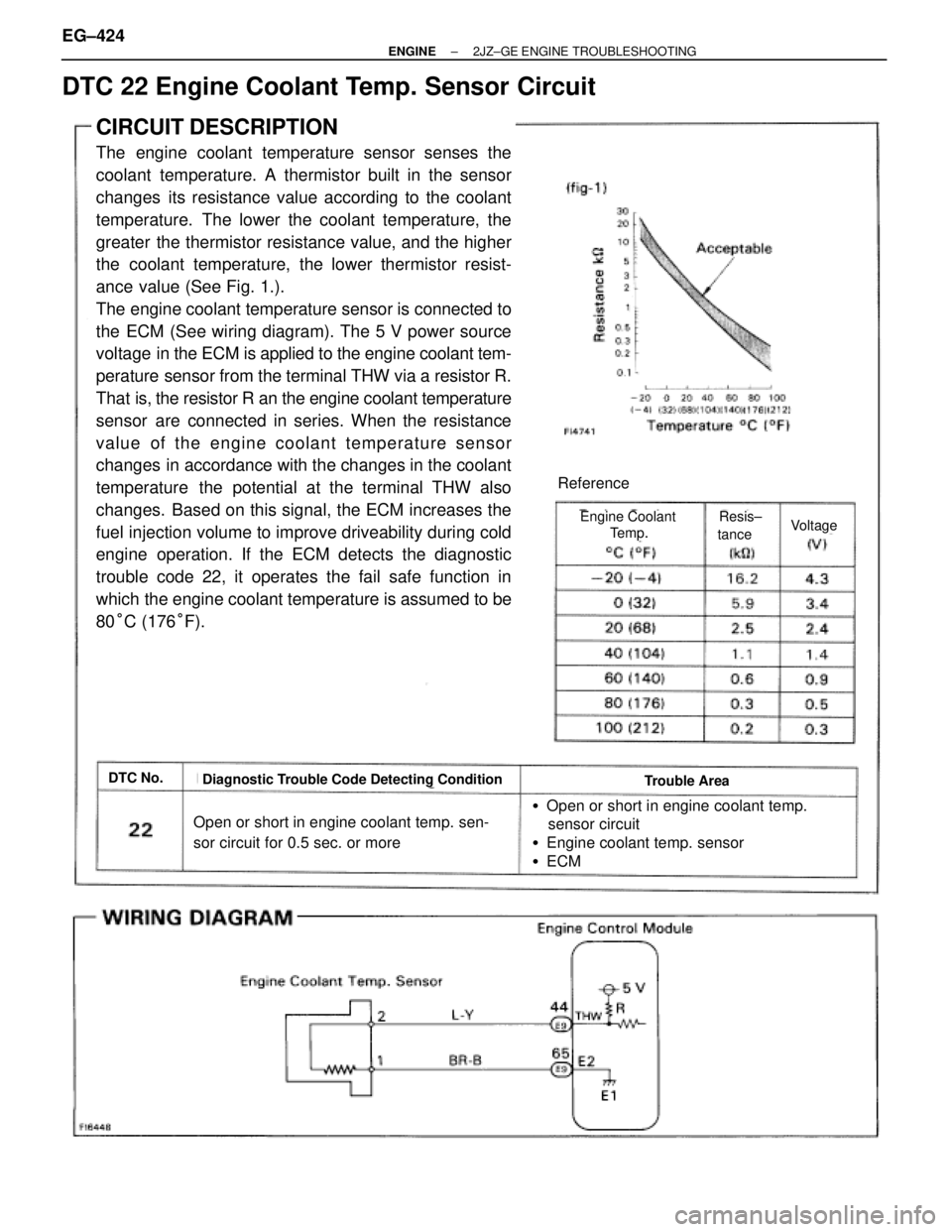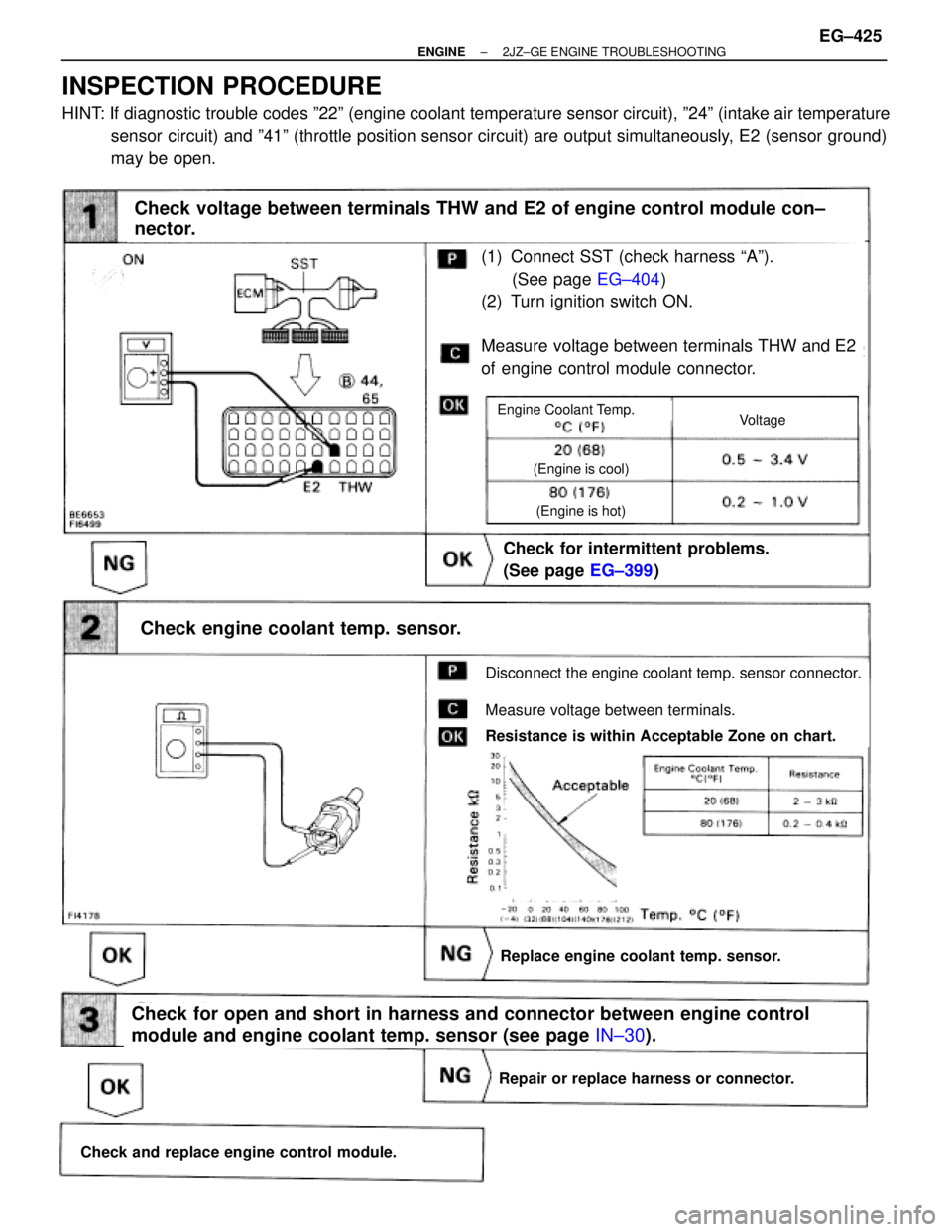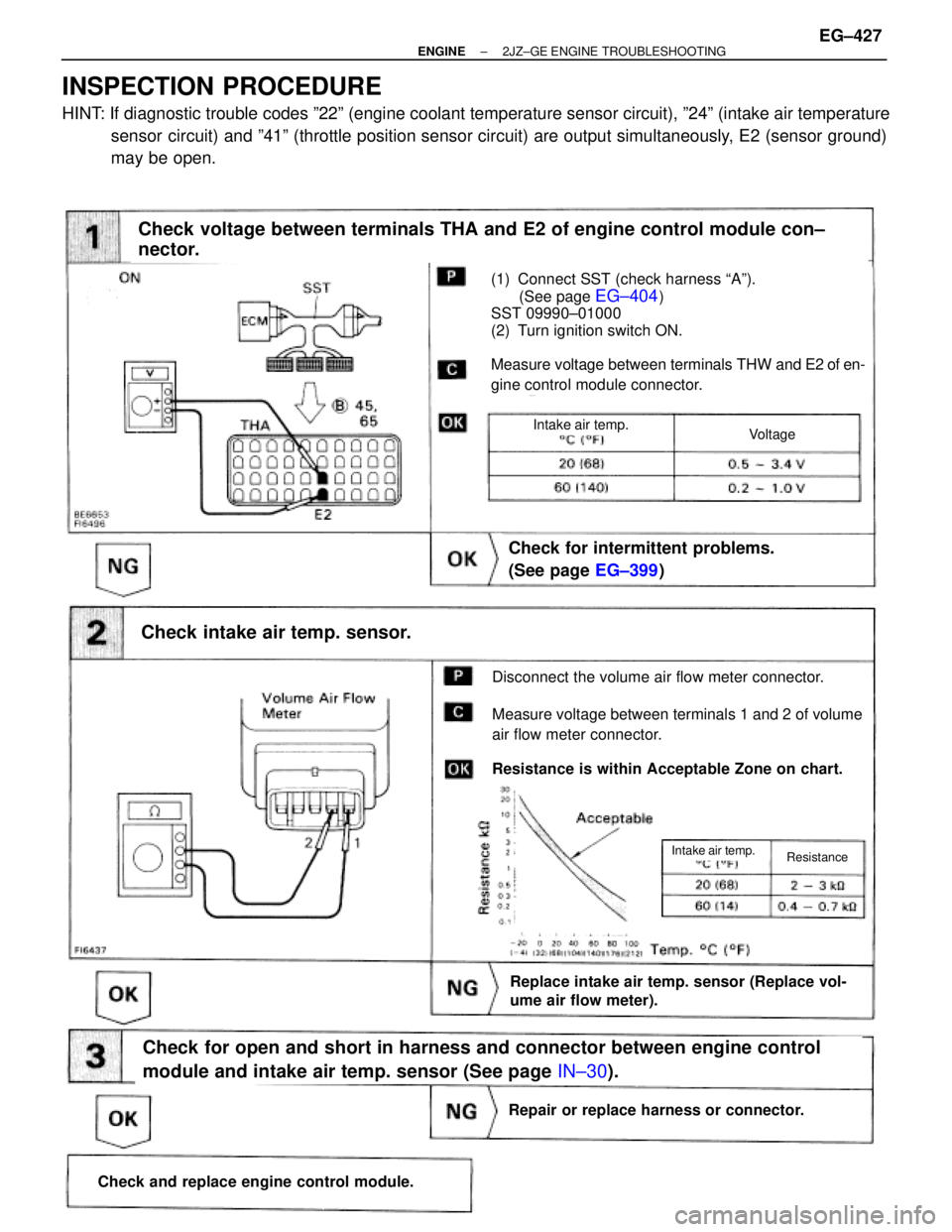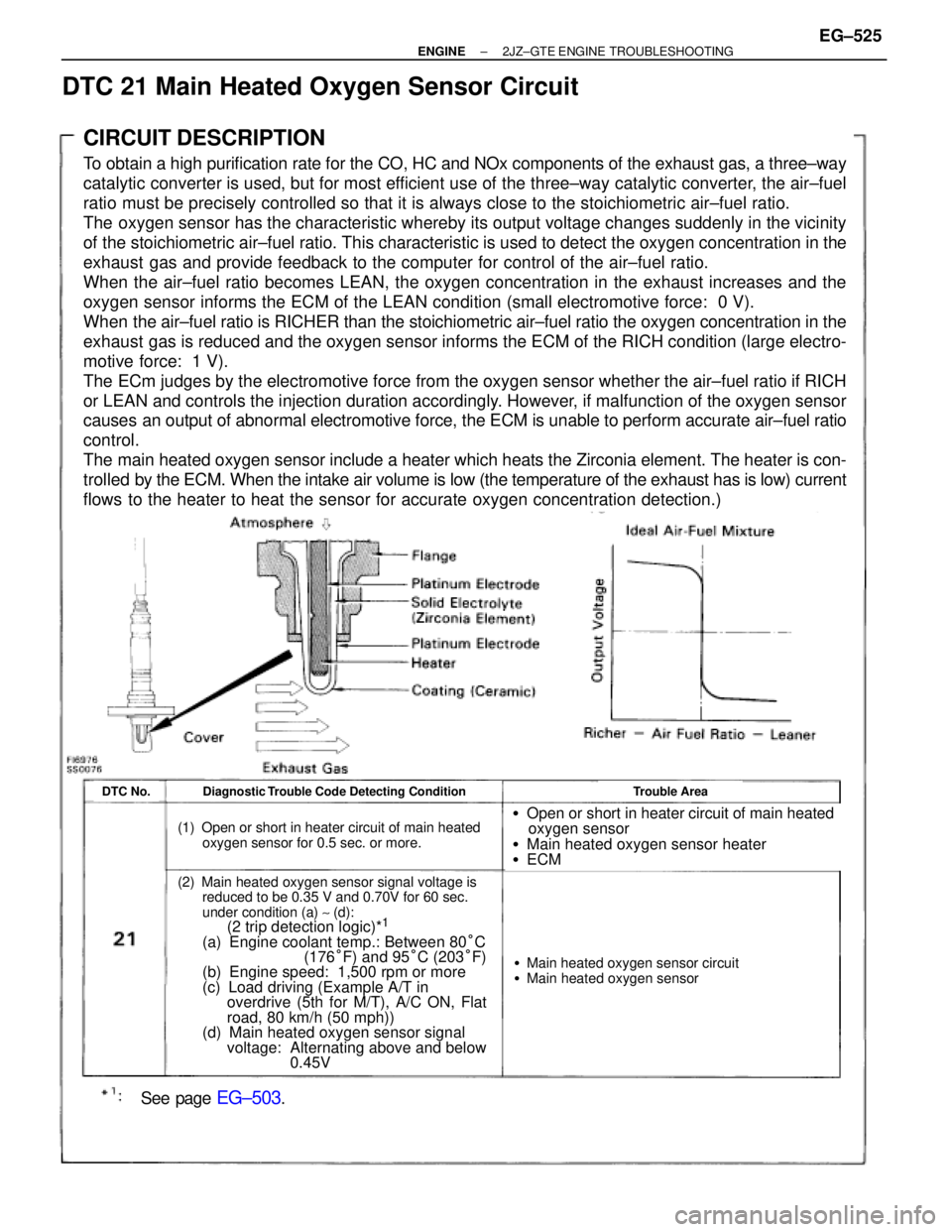Page 1932 of 2543

DTC 22 Engine Coolant Temp. Sensor Circuit
CIRCUIT DESCRIPTION
The engine coolant temperature sensor senses the
coolant temperature. A thermistor built in the sensor
changes its resistance value according to the coolant
temperature. The lower the coolant temperature, the
greater the thermistor resistance value, and the higher
the coolant temperature, the lower thermistor resist-
ance value (See Fig. 1.).
The engine coolant temperature sensor is connected to
the ECM (See wiring diagram). The 5 V power source
voltage in the ECM is applied to the engine coolant tem-
perature sensor from the terminal THW via a resistor R.
That is, the resistor R an the engine coolant temperature
sensor are connected in series. When the resistance
value of the engine coolant temperature sensor
changes in accordance with the changes in the coolant
temperature the potential at the terminal THW also
changes. Based on this signal, the ECM increases the
fuel injection volume to improve driveability during cold
engine operation. If the ECM detects the diagnostic
trouble code 22, it operates the fail safe function in
which the engine coolant temperature is assumed to be
80°C (176°F).
DTC No.Diagnostic Trouble Code Detecting ConditionTrouble Area
Open or short in engine coolant temp. sen-
sor circuit for 0.5 sec. or more
�Open or short in engine coolant temp.
sensor circuit
�Engine coolant temp. sensor
�ECM
Reference
VoltageEngine Coolant
Temp.
Resis±
tance
EG±424± ENGINE2JZ±GE ENGINE TROUBLESHOOTING
Page 1933 of 2543

(See page EG±404)
(1) Connect SST (check harness ªAº).
(See page EG±404)
(2) Turn ignition switch ON.
Measure voltage between terminals THW and E2
of engine control module connector.
Check for intermittent problems.
(See page EG±399)
Check engine coolant temp. sensor.
Replace engine coolant temp. sensor.
Repair or replace harness or connector.
Check and replace engine control module.
Check for open and short in harness and connector between engine control
module and engine coolant temp. sensor (see page IN±30).
Disconnect the engine coolant temp. sensor connector.
Measure voltage between terminals.
Resistance is within Acceptable Zone on chart.
Check voltage between terminals THW and E2 of engine control module con±
nector.
VoltageEngine Coolant Temp.
(Engine is cool)
(Engine is hot)
INSPECTION PROCEDURE
HINT: If diagnostic trouble codes º22º (engine coolant temperature sensor circuit), º24º (intake air temperature
sensor circuit) and º41º (throttle position sensor circuit) are output simultaneously, E2 (sensor ground)
may be open.
± ENGINE2JZ±GE ENGINE TROUBLESHOOTINGEG±425
Page 1934 of 2543

DTC 24 Intake Air Temp. Sensor Circuit
CIRCUIT DESCRIPTION
The intake air temp. sensor is built into the volume air flow meter and senses the intake air temperature.
The structure of the sensor and connection to the ECM is the same as in the engine coolant temp. sensor shown
on page EG±424.
If the ECM detects the diagnostic trouble code º24º, it operates the fail safe function in which the
intake air temper-
ature
is assumed to be 20°C (68°F).
���� �
��� ����DTC No.
����������������� �
���������������� �����������������Diagnostic Trouble Code Detecting Condition
����������������� �
���������������� �����������������Trouble Area
���� ����
24
����������������� �����������������Open or short in intake air temp. sensor circuit for����������������� ������������������ Open or short in intake air temp. sensor circuit
�Intake air tempsensor���� �
��� ����
24����������������� �
���������������� �����������������
Oen or short in intake air tem . sensor circuit for
0.5 sec. or more����������������� �
���������������� �����������������
� Intake air temp. sensor
� ECM
EG±426± ENGINE2JZ±GE ENGINE TROUBLESHOOTING
Page 1935 of 2543

(See page EG±404)
(1) Connect SST (check harness ªAº).
(See page
EG±404)
SST 09990±01000
(2) Turn ignition switch ON.
Measure voltage between terminals THW and E2 of en-
gine control module connector.
Check for intermittent problems.
(See page EG±399)
Check intake air temp. sensor.
Disconnect the volume air flow meter connector.
Measure voltage between terminals 1 and 2 of volume
air flow meter connector.
Resistance is within Acceptable Zone on chart.
Check voltage between terminals THA and E2 of engine control module con±
nector.
Replace intake air temp. sensor (Replace vol-
ume air flow meter).
Check for open and short in harness and connector between engine control
module and intake air temp. sensor (See page IN±30).
Repair or replace harness or connector.
Check and replace engine control module.
VoltageIntake air temp.
ResistanceIntake air temp.
INSPECTION PROCEDURE
HINT: If diagnostic trouble codes º22º (engine coolant temperature sensor circuit), º24º (intake air temperature
sensor circuit) and º41º (throttle position sensor circuit) are output simultaneously, E2 (sensor ground)
may be open.
± ENGINE2JZ±GE ENGINE TROUBLESHOOTINGEG±427
Page 1951 of 2543
INSPECTION PROCEDURE
HINT:
wIf diagnostic trouble code º22º (engine coolant temperature sensor circuit), º24º (intake air temperature
sensor circuit) and º41º (throttle position sensor circuit) are output simultaneously, E2 (sensor ground) may
be open.
(See page EG±219)
Check voltage between VTA1, IDL1 and E2 of engine control module connec-
tor.
(1) Connect SST (check harness ªAº).
(See page EG±404)
SST 09990±01000
(2) Turn ignition switch ON.
(3) Disconnect the vacuum hose from the throttle
body, then apply vacuum to the throttle opener.
(See page EG±219)
Measure voltage between terminals VTA1, IDL1
and E2 of engine control module connector when
the throttle valve is opened gradually from the
closed condition.
Check for intermittent problems.
(See page EG±399)
The voltage should increase steadily in proportion
to the throttle valve opening angle.
Terminal
Throttle Valve
Fully Closed
Fully Open
± ENGINE2JZ±GE ENGINE TROUBLESHOOTINGEG±443
Page 1961 of 2543

(See page EG±397).
CIRCUIT DESCRIPTION
The EGR system is designed to recirculate the exhaust gas, controlled according to the driving condi-
tions, back into the intake air±fuel mixture. It helps to slow down combustion in the cylinder and thus
lower the combustion temperature which, in turn, reduces the amount of NOx emission. The amount
of EGR is regulated by the EGR vacuum modulator according to the load.
If even one of the following conditions is fulfilled,
the VSV is turned ON by a signal from the ECM.
This results in atmospheric air acting on the EGR
valve, closing the EGR valve and shutting off the
exhaust gas (EGR cut±OFF).
�Engine coolant temp. below 50°C (122°F)
�During deceleration (Throttle valve closed)
�Light engine load (amount of intake air very
small).
�Engine speed over 5,200 rpm
�Traction control is operating
DTC No.Diagnostic Trouble Code Detecting ConditionTrouble Area
EGR gas temp. is 70°C (158°F) or less for 1 ~
4 min. under conditions (a) and (b):
(2) trip detection logic)*
(a) Engine coolant temp.: 63°C (145°F) or
more
(b) EGR operation possible (Example A/T in
3rd speed (5th for M/T), A/C ON, 96
km/h (60 mph), Flat road)
�Open in EGR gas temp. sensor circuit
�Short in VSV circuit for EGR
�EGR hose disconnected, valve stuck
�Clogged EGR gas passage
�ECM
DIAGNOSTIC TROUBLE CODE DETECTION DRIVING PATTERN
Purpose of the driving pattern.
(a) To simulate diagnostic trouble code detecting condition after diagnostic trouble code is recorded.
(b) To check that the malfunction is corrected when the repair is completed by confirming that diag±
nostic trouble code is no longer detected.
DTC 71 EGR System Malfunction
± ENGINE2JZ±GE ENGINE TROUBLESHOOTINGEG±453
Page 1989 of 2543
VSV Circuit for Fuel Pressure Control (Only for California spec.)
CIRCUIT DESCRIPTION
The ECM turns on a VSV (Vacuum Switching
Valve) to draw air into the diaphragm cham-
ber of the pressure regulator if it detects that
the temperature of the engine coolant is too
high during engine starting.
The air drawn into the chamber increases the
fuel pressure to prevent fuel vapor lock at
high engine temperature in order to help the
engine start when it is warm.
`Fuel pressure control ends approx. 120 sec.
after then engine is started.
± ENGINE2JZ±GE ENGINE TROUBLESHOOTINGEG±481
Page 2032 of 2543

See page EG±503.
CIRCUIT DESCRIPTION
To obtain a high purification rate for the CO, HC and NOx components of the exhaust gas, a three±way
catalytic converter is used, but for most efficient use of the three±way catalytic converter, the air±fuel
ratio must be precisely controlled so that it is always close to the stoichiometric air±fuel ratio.
The oxygen sensor has the characteristic whereby its output voltage changes suddenly in the vicinity
of the stoichiometric air±fuel ratio. This characteristic is used to detect the oxygen concentration in the
exhaust gas and provide feedback to the computer for control of the air±fuel ratio.
When the air±fuel ratio becomes LEAN, the oxygen concentration in the exhaust increases and the
oxygen sensor informs the ECM of the LEAN condition (small electromotive force: 0 V).
When the air±fuel ratio is RICHER than the stoichiometric air±fuel ratio the oxygen concentration in the
exhaust gas is reduced and the oxygen sensor informs the ECM of the RICH condition (large electro-
motive force: 1 V).
The ECm judges by the electromotive force from the oxygen sensor whether the air±fuel ratio if RICH
or LEAN and controls the injection duration accordingly. However, if malfunction of the oxygen sensor
causes an output of abnormal electromotive force, the ECM is unable to perform accurate air±fuel ratio
control.
The main heated oxygen sensor include a heater which heats the Zirconia element. The heater is con-
trolled by the ECM. When the intake air volume is low (the temperature of the exhaust has is low) current
flows to the heater to heat the sensor for accurate oxygen concentration detection.)
Diagnostic Trouble Code Detecting ConditionDTC No.Trouble Area
(1) Open or short in heater circuit of main heated
oxygen sensor for 0.5 sec. or more.
(2) Main heated oxygen sensor signal voltage is
reduced to be 0.35 V and 0.70V for 60 sec.
under condition (a) ~ (d):
(2 trip detection logic)*1
(a) Engine coolant temp.: Between 80°C
(176°F) and 95°C (203°F)
(b) Engine speed: 1,500 rpm or more
(c) Load driving (Example A/T in
overdrive (5th for M/T), A/C ON, Flat
road, 80 km/h (50 mph))
(d) Main heated oxygen sensor signal
voltage: Alternating above and below
0.45V
�Open or short in heater circuit of main heated
oxygen sensor
�Main heated oxygen sensor heater
�ECM
�Main heated oxygen sensor circuit
�Main heated oxygen sensor
DTC 21 Main Heated Oxygen Sensor Circuit
± ENGINE2JZ±GTE ENGINE TROUBLESHOOTINGEG±525